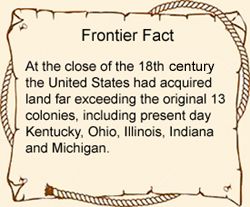
Westward Expansion.
“If a young man is about to commence in the world… we say to him publicly and privately, go to the West. There, your capacities are sure to be appreciated and your industry and energy rewarded.”
— Horace Greeley, editor of the New York Tribune, so urged young men to go West in the 1850s
Articles:
Beginning of Settlement in the American West
The Evolution of Grazing and Agriculture
Mining and Manufacturing in the West
Early Transportation on the Great Plains
The Frontier In History by Emerson Hough
Frontier Types by Theodore Roosevelt
Categories:
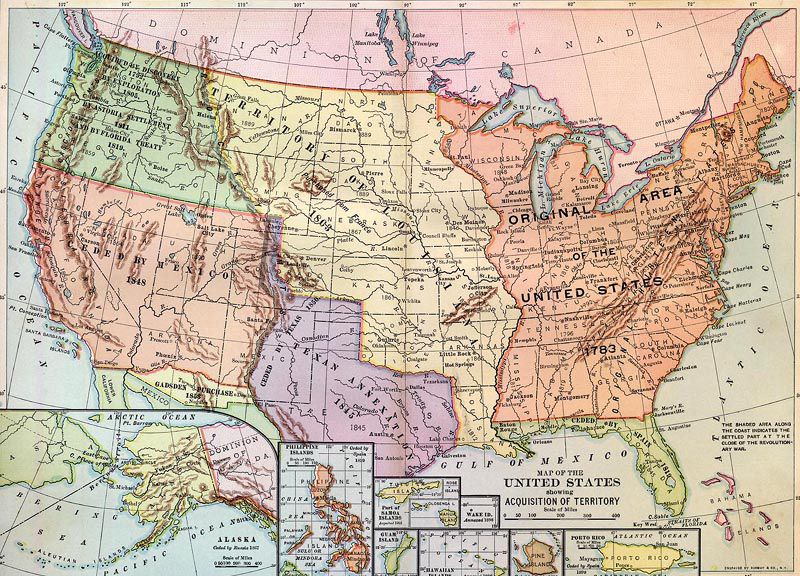
Westward Expansion Map
The expansion of the United States into the territory west of the Mississippi River began with the Louisiana Purchase in 1803. President Thomas Jefferson nearly doubled the nation’s size by negotiating a price of $15 million to purchase 828,800 square miles from France, including all or part of 14 current states. In 1804, Jefferson sent an expedition led by Meriwether Lewis and William Clark to explore the region. The three-year expedition produced a new understanding of the geography and resources of the western part of the continent.
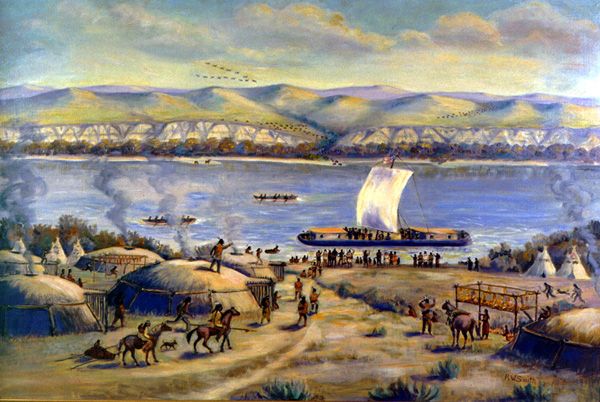
Lewis and Clark on the Upper Missouri River.
Before that time, European immigrants did not stretch far beyond the eastern seaboard. The first British settlers in the New World stayed near the Atlantic Ocean to be close to their lifeline for needed supplies from England. By the 1630s, Massachusetts Bay colonists were pushing into the Connecticut River Valley.
Resistance from the French and the Indians also slowed the westward movement, but by the 1750s, colonists had settled in most of New England. It took American colonists a century and a half to expand as far west as the Appalachian Mountains, a distance of a few hundred miles from the Atlantic coast. It took another 50 years to push the frontier to the Mississippi River.
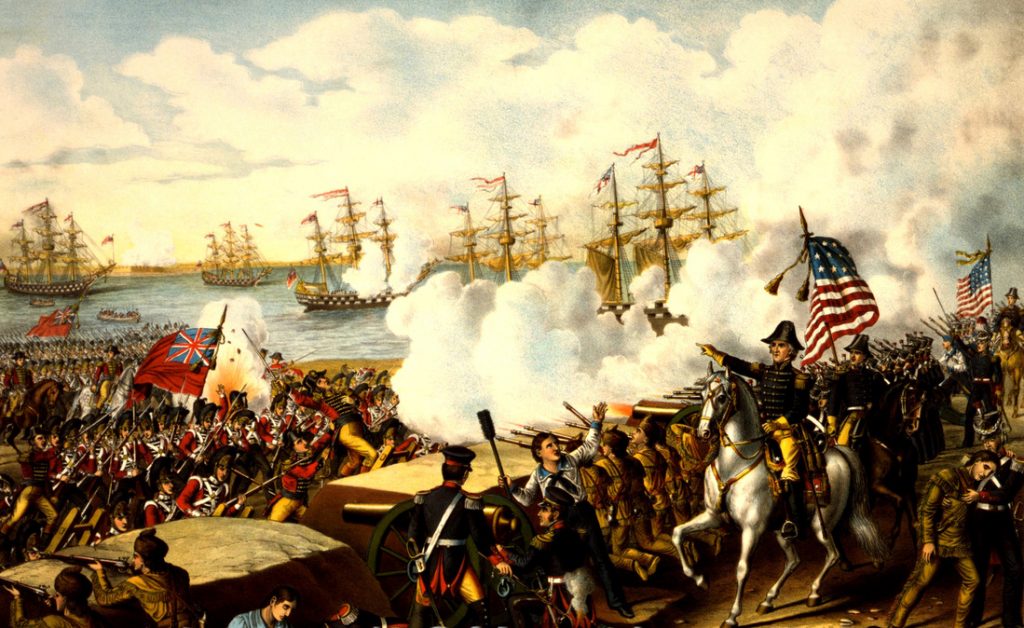
Battle of New Orleans- War of 1812.
Despite some continuous push westward, it was not until the conclusion of the War of 1812 that the westward movement became a significant outpouring of people across the continent. By 1830, the Old Northwest and Old Southwest, which were scarcely populated before the war, began to be settled. Before long, Illinois, Indiana, Missouri, Alabama, and Mississippi were admitted into the Union.
In the 1830s and 1840s, the concept of “Manifest Destiny,” which reasoned that the United States was destined to expand across the entire continent, was used to promote further territorial expansion. The concept of American expansion was much older. John L. O’Sullivan coined the term “Manifest Destiny” in the July/August 1845 issue of the United States Magazine and Democratic Review in an article titled Annexation. Democrats primarily used it to support the expansion plans of the Polk Administration. However, the idea of expansion faced opposition from Whigs like Henry Clay, Daniel Webster, and Abraham Lincoln, who wanted to deepen the economy rather than broaden its expanse.
Americans began to buy into the inevitability of settling unexplored western frontiers, first moving into places such as Michigan, Arkansas, Wisconsin, and Ohio. The nation expanded quickly in the 1840s and 1850s, and in just five years, the United States increased its size by a third. It annexed Texas, negotiated with Britain for half of the Oregon country, and acquired more as a result of a war with Mexico, as noted in this timeline:
-
In 1845, the United States annexed Texas.
-
In 1846, the Oregon Treaty ended British claims to the Oregon Territory.
-
In 1848, following the Mexican-American War, Mexico ceded a significant portion of the West and Southwest to the United States. This included what would become the states of California, Nevada, Utah, parts of Arizona, Colorado, New Mexico, and Wyoming.
-
In 1853, the United States bought an additional tract of land from Mexico.
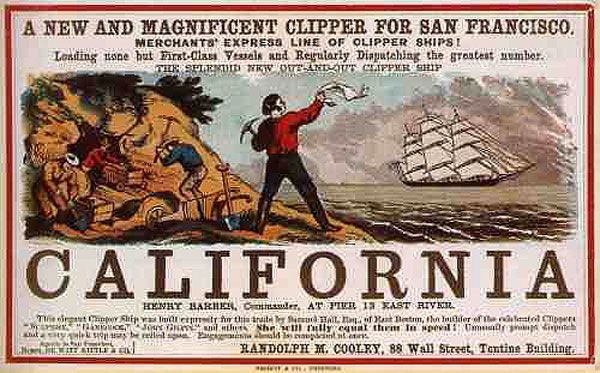
To California during the gold rush.
People then began to move in numbers into Texas, California, and Oregon. The California Gold Rush, the construction of railroads, the Mormons‘ long pilgrimage to Utah, and the blazing of the Santa Fe and Oregon Trails all contributed to the expansion of the “Wild West.”
Between the California Gold Rush and the Civil War, Americans, in growing numbers, filled the Mississippi River Valley, the Southwest Territories, and the newly formed states of Kansas and Nebraska. During the war, gold and silver discoveries drew prospectors—and later settlers—into Oregon, Colorado, Nevada, Idaho, and Montana. However, the most rapid migration occurred after the Homestead Act, passed in 1862, which allowed settlers to claim 160 acres of land for free. Another critical factor was the completion of the first transcontinental railroad in 1869, which led to much more rapid Western migration.
Westward expansion seriously affected Native Americans since continental expansion implicitly meant the occupation and annexation of their lands. The United States continued the European practice of recognizing only limited land rights of indigenous peoples. It sought to expand into the West through the nominally legal purchase of Native American land in treaties. In many cases, these treaties were negotiated and signed by tribal members who lacked the authority to do so, and in some cases, by signers who were unfamiliar with the contents of what they were signing. Despite the treaty’s legality, once one was signed, the government often used force to move the Indians from their homelands.
Indians were encouraged to sell their vast tribal lands and become “civilized,” which meant they should abandon hunting, become farmers, discontinue nomadic lifestyles, become educated in the “white ways,” and abandon their “savage” ceremonies and practices. Advocates of civilization programs believed that settling native tribes would significantly reduce the land needed by the Native Americans and make more land available for homesteading by white Americans.
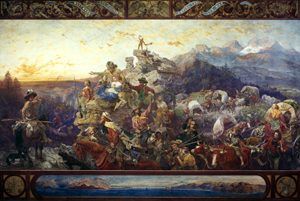
Westward the Course of Empire Takes Its Way, Emanuel Leutze, 1861

